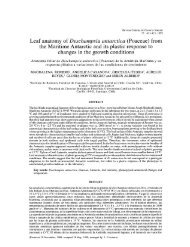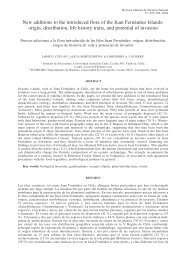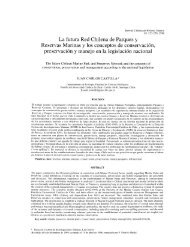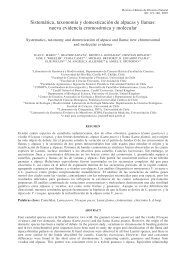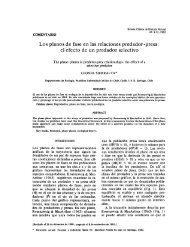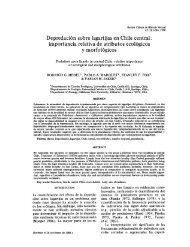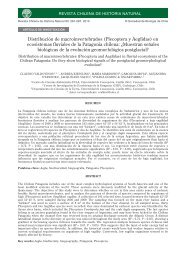Zoogeografía de macroinvertebrados bentónicos de la costa de ...
Zoogeografía de macroinvertebrados bentónicos de la costa de ...
Zoogeografía de macroinvertebrados bentónicos de la costa de ...
You also want an ePaper? Increase the reach of your titles
YUMPU automatically turns print PDFs into web optimized ePapers that Google loves.
aleza <strong>de</strong> <strong>la</strong> data utilizada (Sneath & Sokal 1973 ).<br />
El método <strong>de</strong> agrupamiento correspondió al<br />
UPGMA, recomendado cuando los grupos conformados<br />
no son <strong>de</strong> tamaños en extremo diferentes<br />
(Pielou 1984 ). Finalmente, se estableció el<br />
grado <strong>de</strong> en<strong>de</strong>mismo <strong>de</strong> <strong>la</strong>s tres regiones<br />
zoogeográficas propuestas por Lancellotti &<br />
V ásquez ( 1999) para <strong>la</strong>s <strong>costa</strong>s <strong>de</strong> Chile, consi<strong>de</strong>rando<br />
en<strong>de</strong>mismo a <strong>la</strong> ocurrencia exclusiva <strong>de</strong><br />
una especie en una o más zonas <strong>de</strong>ntro <strong>de</strong> una<br />
particu<strong>la</strong>r región.<br />
RESULTADOS Y DISCUSION<br />
Patrón zoogeográfico <strong>de</strong> biodiversidad<br />
Las 1.601 especies pertenecientes a los 7 phy<strong>la</strong><br />
estudiados se agrupan en 835 géneros, 336 familias<br />
y 76 ór<strong>de</strong>nes (Tab<strong>la</strong> 1). La re<strong>la</strong>ción total <strong>de</strong><br />
taxa se encuentra en el Anexo 1 y los patrones<br />
zoogeográficos y <strong>de</strong> biodiversidad <strong>de</strong> los<br />
<strong>macroinvertebrados</strong> marinos <strong>bentónicos</strong> se entregan<br />
a continuación.<br />
Taxa<br />
ZOOGEOGRAFIA DE ORGANISMOS BENTONICOS 103<br />
TABLA2<br />
Demospongiae (Tab<strong>la</strong> 2, Fig. 2)<br />
Este grupo taxonómico registra un total <strong>de</strong> 76<br />
especies distribuidos en 43 géneros, 28 familias y<br />
11 ór<strong>de</strong>nes, siendo Poecilosclerida el or<strong>de</strong>n más<br />
diverso con 32 especies. Demospongiae evi<strong>de</strong>ncia<br />
un pronunciado gradiente <strong>la</strong>titudinal <strong>de</strong> biodiversidad,<br />
con una escasa representatividad<br />
taxonómica en <strong>la</strong>titu<strong>de</strong>s bajas y gran riqueza en<br />
<strong>la</strong>titu<strong>de</strong>s altas. El quiebre <strong>de</strong> distribución, el cual<br />
también ocurre al nivel <strong>de</strong> género y familia, está<br />
localizado entre <strong>la</strong>s zonas <strong>de</strong> Concepción y<br />
Valdivia lo que correspon<strong>de</strong> al límite <strong>de</strong> dos<br />
unida<strong>de</strong>s faunisticas. Si bien este patrón <strong>de</strong> distribución<br />
podría ser el reflejo <strong>de</strong> un conocimiento<br />
parcial <strong>de</strong> <strong>la</strong> taxonomía y <strong>de</strong> <strong>la</strong> distribución <strong>de</strong>l<br />
grupo (Desqueyroux-Faún<strong>de</strong>z 1995), <strong>la</strong> presencia<br />
<strong>de</strong> este quiebre sugiere una fauna con distintos<br />
orígenes, y atributos opuestos <strong>de</strong> biodiversidad,<br />
con un progresivo dominio hacia <strong>la</strong>titu<strong>de</strong>s altas<br />
<strong>de</strong> especies con mayor afinidad antártica o subantártica<br />
como ha sido propuesto por<br />
Desqueyroux-Faún<strong>de</strong>z & van Soest (1996).<br />
Demospongiae: (a) Número <strong>de</strong> entida<strong>de</strong>s taxonómicas por Or<strong>de</strong>n y (b) Biodiversidad<br />
zoogeográfica a través <strong>de</strong>l gradiente <strong>la</strong>titudinal (zonas)<br />
Demospongiae: (a) Number of taxonomic entities by Or<strong>de</strong>r, and (b) Zoogeographic biodiversity along<br />
the <strong>la</strong>titudinal gradient (zones)<br />
Or<strong>de</strong>n<br />
Familia<br />
Género<br />
Especie<br />
Or<strong>de</strong>n<br />
Poecilosclerida<br />
Hadromerida<br />
Petrosida<br />
Axinellida<br />
Haplosclerida<br />
Dictyoceratida<br />
Astrophorida<br />
Halichondrida<br />
Homosclerophorida<br />
Spirophorida<br />
Dendroceratida<br />
(b)<br />
Arica Antofagasta Coquimbo<br />
2 3 4<br />
2 3 6<br />
2 3 7<br />
2 3 7<br />
(a) Re<strong>la</strong>ción Taxonómica<br />
Familia Género<br />
9 17<br />
5 7<br />
2 4<br />
3 5<br />
2 2<br />
2 3<br />
Biodiversidad Zoogeográfica<br />
Valparaíso Concepción Valdivia<br />
4 7 9<br />
8 14 24<br />
9 17 31<br />
11 20 40<br />
Especie<br />
32<br />
11<br />
10<br />
6<br />
6<br />
4<br />
2<br />
2<br />
Archipié<strong>la</strong>go Archipié<strong>la</strong>go Estrecho <strong>de</strong> Cabo<br />
<strong>de</strong> Chiloé Los Chonos Magal<strong>la</strong>nes <strong>de</strong> Hornos<br />
9 9 10 9<br />
24 22 23 22<br />
32 31 32 32<br />
47 49 52 53



